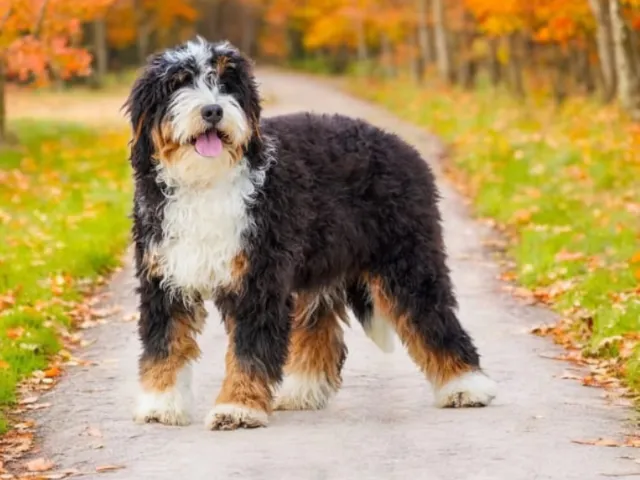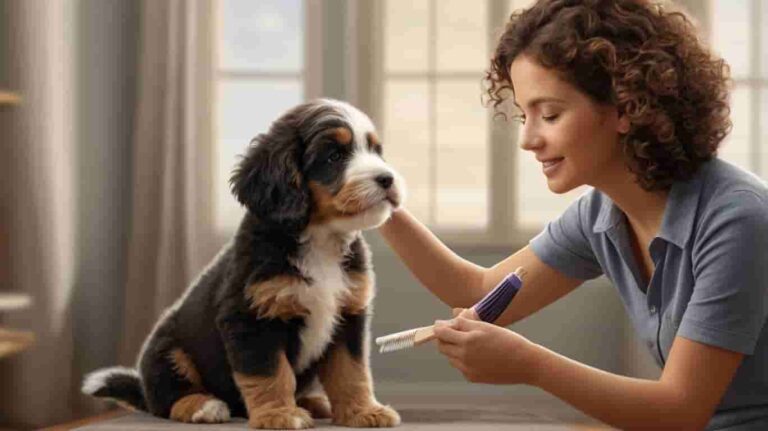The Impact of Generation on Bernedoodle Temperament and Predictability
Bernedoodles, a hybrid cross between Bernese Mountain Dogs and Poodles, are cherished for their affectionate, intelligent, and playful personalities. However, their temperament can vary significantly depending on their generational designation—F1, F1b, F2, or multigenerational.
These labels reflect the genetic ratio of Bernese Mountain Dog to Poodle, influencing not only physical traits like coat type but also behavioral tendencies. This guide explores how these generations differ in temperament consistency, the role of selective breeding in shaping desired traits, and the challenges of predicting behavior in hybrid litters.
A case study of two F1 Bernedoodle siblings illustrates the variability within a single litter and how owners can adapt training to suit individual temperaments.

Generational Breakdown and Genetic Ratios
Bernedoodle generations are defined by their parentage, which determines the proportion of Bernese Mountain Dog and Poodle genetics. Each generation has implications for temperament predictability due to the interplay of inherited traits.
F1 Bernedoodles
- Genetic Makeup: 50% Bernese Mountain Dog, 50% Poodle
- Temperament Characteristics: F1 Bernedoodles often exhibit a blend of the Bernese’s calm, loyal, and gentle nature and the Poodle’s intelligence, playfulness, and sensitivity. However, the balance is highly variable, even within a single litter. Some puppies may lean toward the Bernese’s relaxed demeanor, while others may inherit the Poodle’s high energy and alertness.
- Consistency: Temperament is less predictable due to the equal genetic split. The expression of traits depends on which genes dominate, leading to a wide range of personalities, from outgoing and playful to reserved and calm.

F1b Bernedoodles
- Genetic Makeup: 75% Poodle, 25% Bernese Mountain Dog (F1 Bernedoodle crossed with a Poodle)
- Temperament Characteristics: F1b Bernedoodles tend to exhibit more Poodle-like traits, such as higher energy, greater trainability, and increased sensitivity. They may be more playful and active than F1s but can still inherit some of the Bernese’s gentle and loyal qualities. The reduced Bernese influence may lessen the stubborn streak seen in some F1s.
- Consistency: More predictable than F1s due to the higher Poodle genetic contribution, which often stabilizes traits like intelligence and low-shedding coats. However, temperament can still vary depending on the specific Poodle parent’s traits.

F2 Bernedoodles
- Genetic Makeup: 50% Bernese Mountain Dog, 50% Poodle (two F1 Bernedoodles crossed)
- Temperament Characteristics: F2 Bernedoodles have a genetic profile similar to F1s but are less common due to their unpredictability. The combination of two hybrid parents increases the variability in trait expression, potentially resulting in puppies that closely resemble either parent breed or a mix. They may display a range of temperaments, from highly energetic to more laid-back.
- Consistency: Least predictable among the generations. The recombination of genes from two F1 parents can lead to significant variation in behavior, making it challenging to anticipate specific traits.

Multigenerational Bernedoodles
- Genetic Makeup: Variable, typically involving crosses of F1b, F2, or later generations with other Bernedoodles or Poodles
- Temperament Characteristics: Multigenerational Bernedoodles are bred to stabilize specific traits, such as a calm demeanor, low shedding, or high trainability. They often lean toward Poodle-like intelligence and playfulness but can retain the Bernese’s affectionate and gentle nature. Responsible breeders select for balanced temperaments suitable for family life or therapy roles.
- Consistency: Most predictable due to selective breeding over multiple generations. Breeders use genetic testing to identify and pair dogs with desired traits, reducing variability in temperament and physical characteristics.

Selective Breeding for Desired Traits
Breeders aim to enhance specific temperament traits to meet the needs of prospective owners, such as families seeking calm companions or individuals needing therapy dogs. The process involves:
- Trait Selection:
- Calmness: Breeders may prioritize Bernese Mountain Dog traits, selecting parents with gentle, loyal, and relaxed dispositions. This is common in multigenerational breeding programs aiming for therapy or family dogs.
- Playfulness: To emphasize Poodle-like energy and intelligence, breeders may choose Poodle or F1b parents with lively, engaging personalities, ideal for active households or service roles.
- Trainability: Poodle genetics are favored for their high intelligence and responsiveness to training. F1b and multigenerational Bernedoodles often inherit this trait, making them easier to train than F1s or F2s, which may exhibit Bernese stubbornness.
- Genetic Testing: Modern breeders use tools like Embark or Paw Print to screen for genes influencing behavior, such as those related to temperament stability or sensitivity. Testing for coat-related genes (e.g., RSPO2 for furnishings, KRT71 for curl) indirectly supports temperament selection by ensuring consistency in physical traits, which often correlates with behavioral predictability.
- Parental Selection: Responsible breeders choose parents with proven temperaments, often evaluating them through behavioral assessments or real-world performance (e.g., as therapy dogs). This is especially critical in multigenerational breeding to stabilize desired traits.

Challenges in Predicting Behavior
Predicting temperament in Bernedoodles is complex due to their hybrid nature. Key challenges include:
- Genetic Variability: The mix of Bernese and Poodle genes leads to diverse outcomes, especially in F1 and F2 generations. Even within a litter, puppies may inherit vastly different combinations of traits, affecting their energy levels, sociability, and trainability.
- Dominance of Traits: It’s difficult to predict which parent’s traits will dominate. For example, a puppy may inherit the Bernese’s stubbornness or the Poodle’s sensitivity, impacting training needs.
- Environmental Influence: Temperament is shaped by both genetics and environment. Early socialization, training, and owner interaction significantly affect a puppy’s behavior, complicating predictions based solely on genetics.
- Limited Breed History: As a relatively new hybrid (standardized in 2003), Bernedoodles lack the long-term data available for purebreds, making behavioral outcomes less certain compared to breeds with established standards.
- Health and Behavior Link: Health issues like hip dysplasia or allergies, inherited from either parent, can influence behavior (e.g., discomfort may lead to irritability). This adds another layer of unpredictability.

Case Study: F1 Bernedoodle Siblings
To illustrate the variability in F1 Bernedoodle temperaments, consider two siblings from the same litter, born to a purebred Bernese Mountain Dog and a Standard Poodle.
Background
- Litter: F1 Bernedoodles, 50% Bernese, 50% Poodle
- Siblings: Max (male, outgoing) and Luna (female, reserved)
- Owners: Max’s family is active, with two children; Luna’s owner is a single professional with a quieter lifestyle.
Max: The Outgoing Entertainer
- Temperament: Max is high-energy, playful, and sociable, likely inheriting more Poodle-like traits. He loves dog parks, greets strangers enthusiastically, and thrives on activity.
- Training Adaptations: Max’s family used positive reinforcement to channel his energy into tricks and agility training. They enrolled him in group classes to satisfy his social nature, focusing on commands like “sit” and “stay” to manage his exuberance. Regular exercise (daily walks and playtime) prevents boredom-driven chewing.
- Challenges: Max’s high energy required consistent mental stimulation. Without it, he became destructive, chewing furniture during his first year. His family introduced puzzle toys and increased outdoor time to address this.

Luna: The Reserved Companion
- Temperament: Luna is calm, gentle, and cautious, reflecting more Bernese traits. She prefers quiet environments and is slow to warm up to new people or dogs.
- Training Adaptations: Luna’s owner used gentle, patient training methods, avoiding harsh tones due to her sensitivity. One-on-one sessions at home helped build her confidence, with treats reinforcing basic commands. Socialization was gradual, starting with short, controlled interactions at the park.
- Challenges: Luna’s reserved nature made her hesitant in new situations, sometimes leading to anxiety. Her owner worked with a trainer to desensitize her to unfamiliar stimuli, ensuring she felt secure.

Analysis
Max and Luna highlight the variability within an F1 litter. Max’s Poodle-driven energy contrasted with Luna’s Bernese-influenced calmness, requiring tailored training approaches. Max thrived in a high-energy household, while Luna suited a calmer environment. This variability underscores the challenge of predicting F1 temperament and the importance of matching puppies to owners’ lifestyles.
Recent Studies and Insights
Recent research on canine behavior and genetics provides context for understanding Bernedoodle temperament:
- Heritability of Behavior: Studies show that behavioral traits like biddability (responsiveness to human direction) are highly heritable but vary significantly among individual dogs, even within breeds or hybrids. This supports the observed variability in Bernedoodle litters, particularly in F1 and F2 generations.
- Genetic Testing Advances: Tools like Embark allow breeders to screen for genes influencing coat and health, indirectly aiding temperament predictability by ensuring consistency in breeding pairs. However, behavioral genetics is less understood, limiting precise predictions.
- Hybrid Vigor: F1 Bernedoodles benefit from hybrid vigor, potentially reducing health-related behavioral issues (e.g., irritability from joint pain). However, this advantage diminishes in F2 and later generations as genetic problems from purebred ancestors may reemerge,.

Practical Implications for Owners
- Choosing a Generation: Select a generation based on lifestyle. F1b or multigenerational Bernedoodles are better for allergy sufferers or those seeking predictability, while F1s suit those open to varied temperaments. F2s are less common due to their unpredictability.
- Training Considerations: Use positive reinforcement, especially for Poodle-influenced dogs, which are sensitive to negative feedback. Address Bernese stubbornness with patience and consistency, starting training early.
- Socialization: Early, controlled socialization is crucial, particularly for reserved puppies, to prevent anxiety or fearfulness.
- Breeder Selection: Choose breeders who perform genetic testing and temperament assessments on parents to increase the likelihood of desired traits. Ask for health histories and meet the parents if possible.

Conclusion
The temperament of Bernedoodles varies significantly across generations due to differences in genetic ratios. F1 Bernedoodles offer a balanced but unpredictable mix of Bernese and Poodle traits, F1b leans toward Poodle-like energy and trainability, F2 is highly variable, and multigenerational Bernedoodles provide the most consistency through selective breeding.
Breeders play a critical role in shaping temperament by selecting for traits like calmness or playfulness, but challenges in predicting behavior persist due to genetic variability, environmental factors, and the breed’s young history.
The case study of Max and Luna illustrates how owners can adapt training to suit individual temperaments, highlighting the importance of flexibility and early intervention. By understanding generational differences and working with responsible breeders, prospective owners can find a Bernedoodle that aligns with their lifestyle and expectations.
Below is a concise FAQ section addressing common questions about the impact of generation on Bernedoodle temperament and predictability, based on the analytical guide provided. Since no specific external FAQs were sourced, these are crafted to cover key points from the guide and common owner concerns.

FAQs: Impact of Generation on Bernedoodle Temperament and Predictability
1. What is the main difference in temperament between F1, F1b, F2, and multigenerational Bernedoodles?
F1 Bernedoodles (50% Bernese Mountain Dog, 50% Poodle) have a balanced but unpredictable mix of calm, loyal Bernese traits and energetic, intelligent Poodle traits. F1b (75% Poodle, 25% Bernese) lean toward Poodle-like playfulness and trainability, with more consistency. F2 (F1 x F1) are highly variable, similar to F1 but less predictable due to hybrid parentage.
Multigenerational Bernedoodles, bred over multiple generations, are the most consistent, often tailored for specific traits like calmness or therapy suitability.
2. Why is temperament harder to predict in F1 and F2 Bernedoodles?
F1 and F2 Bernedoodles have a 50/50 genetic split or hybrid parentage, leading to varied trait expression. Genes from either parent (Bernese or Poodle) can dominate unpredictably, resulting in diverse personalities within a litter, from outgoing to reserved. Environmental factors and limited breed history further complicate predictions.
3. How do breeders influence Bernedoodle temperament?
Breeders select parents with desired traits, like calmness for therapy roles or playfulness for active families, using behavioral assessments and genetic testing (e.g., Embark). In multigenerational breeding, they pair dogs to stabilize traits, increasing predictability. Choosing parents with proven temperaments is key, especially for F1b and multigenerational litters.
4. Can I expect the same temperament from siblings in the same Bernedoodle litter?
No, especially in F1 litters. Siblings can vary significantly due to random gene combinations. For example, one puppy may be outgoing and Poodle-like, while another is calm and Bernese-like, as seen in the case study of Max and Luna. Tailored training and socialization are essential to suit each puppy’s personality.
5. Which Bernedoodle generation is best for a calm, family-friendly dog?
Multigenerational Bernedoodles are often the best choice for calm, predictable temperaments, as breeders select for gentle, family-friendly traits over generations. F1b can also work if bred from a calm parent, but F1 and F2 may vary more and require active households if they inherit Poodle energy.
6. How does training differ for Bernedoodles with different temperaments?
Poodle-influenced Bernedoodles (common in F1b) are sensitive and respond well to positive reinforcement but may need mental stimulation to prevent boredom. Bernese-influenced dogs (more in F1 or F2) can be stubborn, requiring patient, consistent training. Reserved puppies need gradual socialization to build confidence, while outgoing ones benefit from structured activities like agility.
7. Are there health issues that affect Bernedoodle temperament?
Yes, health issues like hip dysplasia or allergies, inherited from either parent, can cause discomfort and lead to irritability or behavioral changes. This is more likely in F2 or later generations if genetic issues reemerge, emphasizing the need for health screenings by breeders.
8. How can I choose a Bernedoodle with a predictable temperament?
Choose a reputable breeder who uses genetic testing and temperament assessments for parents. Opt for F1b or multigenerational Bernedoodles for greater consistency. Meet the parents if possible, and discuss your lifestyle with the breeder to match a puppy’s likely temperament to your needs.
9. Does early socialization impact Bernedoodle temperament?
Absolutely. Early, controlled socialization shapes behavior, especially for reserved puppies prone to anxiety or cautiousness. It helps all Bernedoodles, regardless of generation, develop confidence and adaptability, complementing their genetic predispositions.
10. Where can I learn more about choosing a Bernedoodle?
Consult reputable breeders or resources like genetic testing platforms (e.g., Embark) for insights on health and temperament. For general breed information, check trusted sites like the American Kennel Club (AKC) or breeder websites, though specific Bernedoodle data may be limited due to their hybrid status.
References
If you need further details about the topic, you can get additional details here:
- American Kennel Club (AKC)
https://www.akc.org/dog-breeds/bernedoodle/ - Embark Veterinary
https://embarkvet.com/ - Paw Print Genetics
https://www.pawprintgenetics.com/ - Journal of Veterinary Behavior
https://www.journalvetbehavior.com/ - International Association of Animal Behavior Consultants (IAABC)
https://iaabc.org/ - SwissRidge Kennels
https://www.swissridgekennels.com/bernedoodles/ - American Veterinary Medical Association (AVMA)
https://www.avma.org/
Enjoyed this post? “We have many helpful blog posts about Bernedoodles — you might want to check them out!”
Genetic Influences on Bernedoodle Coat Types and Hypoallergenic Properties
Managing Hereditary Health Risks in Bernedoodles: A Deep Dive into Genetics
Bernedoodle Service Dog Training – Advanced Techniques for Therapy & Assistance Tasks
There are many helpful blog posts about Golden Retriever — you might want to read them.
Golden Retriever Aggression: Causes, Prevention, and Facts (2025)
Do Golden Retrievers Bark a Lot? Understanding Their Barking Habits
How to Keep Your Golden Retriever Active and Healthy | Expert Wellness Tips






